Class 11 Biology Chapter 8 Cell: The Unit of Life, AHSEC Class 11 Biology Question Answer, HS 1st year Biology notes to each chapter are provided in the list so that you can easily browse throughout different chapters Assam Board Class 11 Biology Chapter 8 Cell: The Unit of Life Question Answer and select needs one.
Class 11 Biology Chapter 8 Cell: The Unit of Life
Also, you can read the SCERT book online in these sections Solutions by Expert Teachers as per SCERT (CBSE) Book guidelines. These solutions are part of SCERT All Subject Solutions. Here we have given Assam Board Class 11 Biology Chapter 8 Cell: The Unit of Life Solutions for All Subjects, You can practice these here.
Cell: The Unit of Life
Chapter – 8
VERY SHORT ANSWER TYPE QUESTIONS
Q.1. What is cell ?
Ans :- Cell is the fundamental structural and functional unit of life.
Q.2. Who first describe a live cell ?
Ans :- Anton van leeuwenhoek.
Q.3. Who discovered nucleus ?
Ans :- Robert Brawn.
Q.4. Who discovered the presence of thin outer layer in a cell.
Ans :- Theodore Schwann.
Q.5. Who formulated cell theory ?
Ans :- Schleiden and schwann.
Q.6. Name the non membrane bound organelles found in our cell.
Ans :- Ribosome.
Q.7. Name the largest single cell ?
Ans :- Egg of an ostrich.
Q.8. What is mesosome ?
Ans :- Is the extension of plasma membrane into the cell.
Q.9. Write the function of Mesosome ?
Ans :- It helps in the formation of cell wall, DNA replication and distribution to daughter cells.
Q.10. Name the 3 parts of flagellum ?
Ans :- Filament, hook and basal body.
Q.11. What is polysome ?
Ans :- Several ribosome may attach to a single mRNA and form a chain called polysome.
Q.12. What is passive transport ?
Ans :- Molecules which can move across the membrane without requirement of energy is called passive transport.
Q.13. What is Centromere ?
Ans :- The primary construction in termed as centromere.
Q.14. What is kinetochores ?
Ans :- The disc like structure which is present on the side of centromere is called kinetochores.
Q.15. Name the 2 types of ER present is a cell ?
Ans :- They are SER and RER.
Q.16. Who discovered golgi apparatus ?
Ans :- Camillo golgi.
Q.17. Write the function of primary wall ?
Ans :- It helps in growth of plants.
Q.18. Name the widely accepted model of cell membrane ?
Ans :- Fluid mosaic model.
Q.19. How active transport differ from passive transport ?
Ans :- In active transport energy is required where as in passive transport energy is not required.
Q.20. How SER differ from RER ?
Ans :- SER doesn’t bear Ribosome on their surface and help in lipid synthesis where as RER bear Ribosome on their surface and help in protein synthesis.
Q.21. How cell wall of algae differ from the cell wall of other plants ?
Ans :- Cell wall of algae is made of cellulose, galactans, mannans, calcium carbonate while the cell wall of other plant consist of cellular, hemicellulase, pectins and proteins.
Q.22. What is lysosomes ?
Ans :- Lysosomes are membrane bound vesicular structure and they are very rich in hydrolytic enzymes like lipares, carbohephases.
Q.23. What is tonoplast ?
Ans :- The vacuole is bound by a single membrane called tonoplast. The tonoplas facilitates the transport of a number of ions and other materials against the concentration gradient into the vacuole.
Q.24. Write about he structure of mitochondria ?
Ans :- It is a sausage on cylindrical shaped structure. Each mitochondria is a double membrane bound structure with outer membrane and inner membrane. The inner membrane forms a number of infoldings called cristae.
Q.25. Why Mitochondria is also termed an power house of the cell ?
Ans :- They are the sites of aerobic respiration. They produce cellular energy in the form of ATP, hence they are called powerhouse of the cell.
Q.26. Distinguish between Amyloplast and leucoplast ?
Ans :- Amyloplast store carbohydrates but leucoplast store oils and fats.
Q.27. Give the diagrammatic representation of internal structure of cilia/flagella.
Ans :-
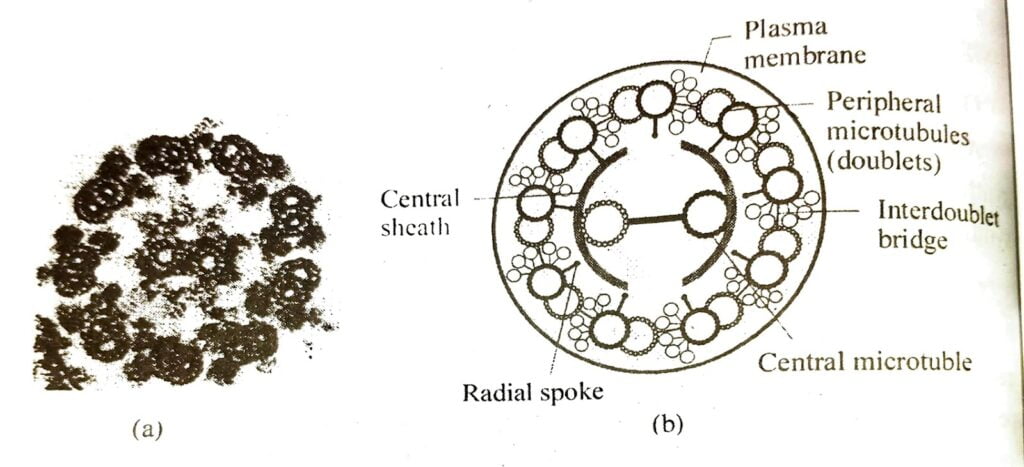
Q.28. Draw the structure of mitochondria and locate the following parts.
Matrix, Crista, Inner membrane
Ans :-
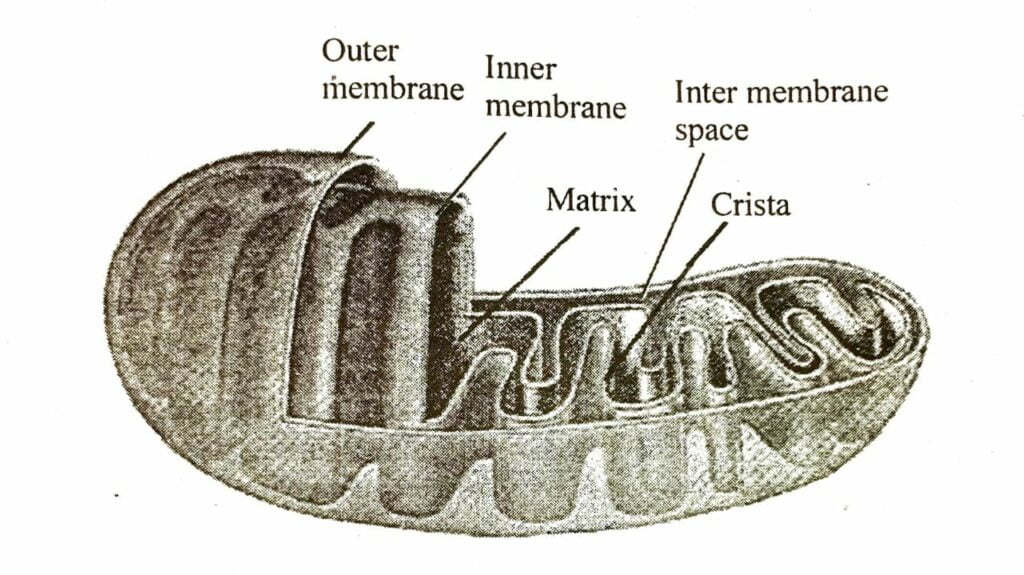
Q.29. Distinguish between 80 S ribosome and 70 S ribosomes ?
Ans :- 80 S ribosomes are found in eukaryotic cells and the two subunits are 60 S and 40 S whereas 70 S ribosomes are found in prokaryotes, chloroplast and mitochondria and the two subunits are 50 S and 30 S.
Q.30. Chromatin is composed of what ?
Ans :- It contain DNA, basic protein histones, non histone proteins and RNA.
Q.31. Write the function of cell wall.
Ans :- (i) It give protection.
(ii) It act as barrier to unwanted molecules.
(iii) It provide rigidity.
Q.32. What is middle lamella ? What is its function ?
Ans :- Middle Lamella is the layer of cell wall. It holds the neighbouring or adjacent cells together.
Q.34. What is the difference between cisface and maturing cell thanks face.
Ans :- The convex side of golgi bodies facing the nucleus is called where as the concave side of the golgi complex, fairy the outer surface of the cell is trans face.
Q.35. What is chloroplast ? Where it is found ?
Ans :- Chloroplast is a type of particles found in the mesophyll layer of the cell.
SHORT ANSWER TYPE QUESTIONS
Q.36. Distinguish between prokaryote and Eukaryotic cells.
Ans :-
| Prokaryotic | Eukaryotic cells |
| (i) Lack a nuclear membrane. | (i) Possess a true nucleus. |
| (ii) They have 70S ribosome. | (ii) They have 80 Sribosome. |
| (iii) Export ribosome no other organelles are present. | (iii) All the organelles are present. |
Q.37. Write about the cell envelop of the prokaryotic cells.
Ans :- Cell envelop consist of tightly bound 3 layered structure ie.
| Outermost layer | Glycocalyx. |
| Middle layer | Cell wall and |
| Inner layer | Plasma membrane glycocalyx differs in composition and thickness among differ ent bacteria ie. |
| It could be a loose sheath | Slim layer. In some it is very hard. |
| And though called | Capsule. |
Q.38. Draw a well label diagram of a plant cell.
Ans :-
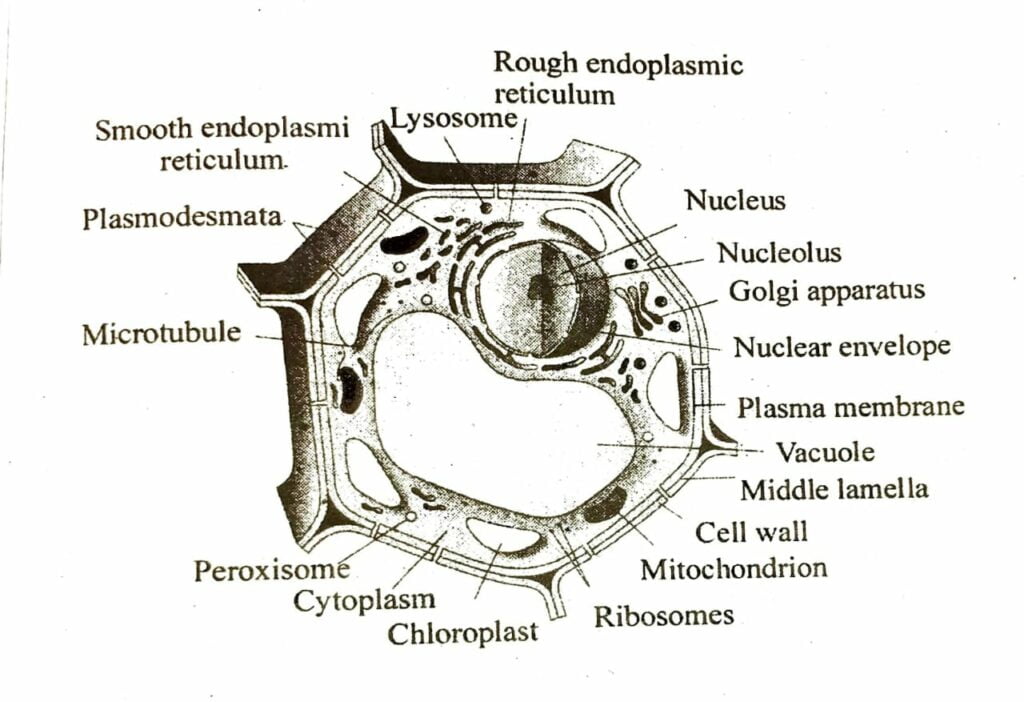
Q.39. Draw a well labelled diagram of an animal cell.
Ans :-
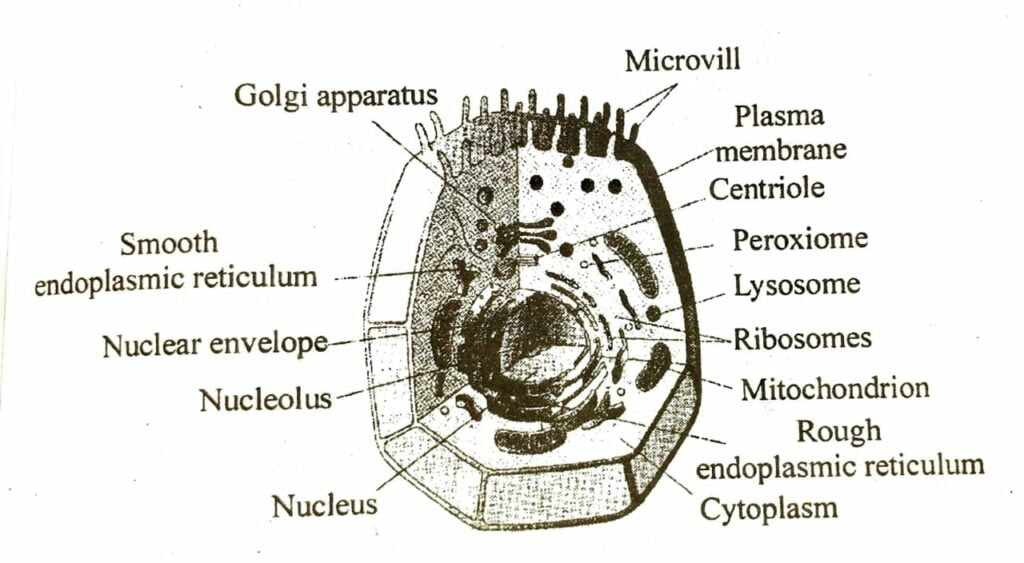
Q.40. Explain the Fluid mosaic model of plasma membrane.
Ans :- Fluid Mosaic model was proposed by singer and Nicolson (1972) to explain the structure of cell membrane.
Cell membrane is compared to lipids that are arranged in a bilayer. Also, the lipids are arranged within the membrane with the polar head towards the outer sides and hydrophilic tails towards the inner part. Some proteins which embedded in the lipid layer are called integral proteins and they cannot be separated from the membrane easily some large globular integral proteins which project beyond the lipid layer on both the sides are believed to have channels through which water soluble material can pass across.
Q.41. Who formulated the cell theory? What does it explain?
Ans :- Schleiden and schwann together formulated the cell theory.
Cell theory as understood today is –
(i) All living organisms are composed of cells and products of cells.
(ii) All cells arise from pre existing cells.
Q.42. What are plastids? How many types are there? Name them. How elaioplast detection aleuroplast.
Ans :- Plastids are a type of organelles found in plant cell and it gives colour to the plants.
There are 3 types of plastids. They are chromoplasts, chloroplast and leucoplast.
Leucoplasts store oils and fats whereas the aleuroplasts store protein.
LONG ANSWER TYPE QUESTIONS
Q.43. Draw and explain the structure of chloroplast.
Ans :-
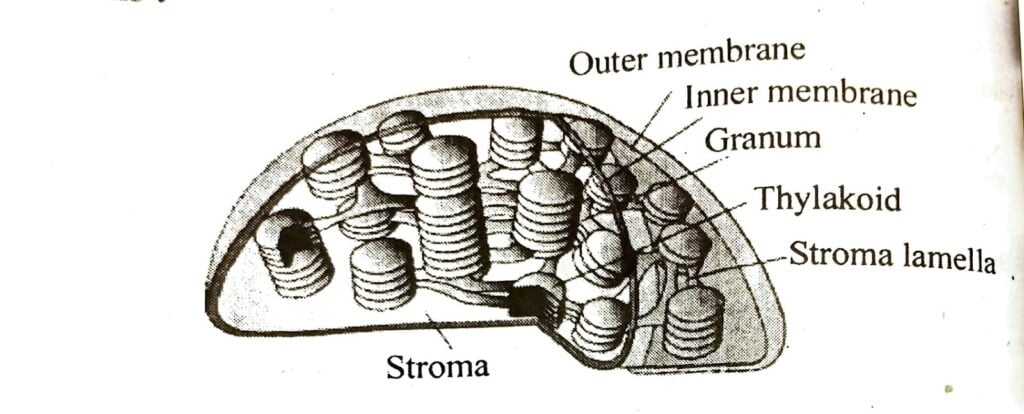
Chloroplast may be lens-shaped, oval, spherical, discoids or even ribbon the organelles having variable length. They are double membrane structures enclosing the colourless matrix called stroma. In the matrix numerous flat membranous sac like structures called thylakoid occurs in the form of stacks of coin called grana. The grana are linked with one another by stroma lamellae. Chlorophyll pigments are found in the thylakoid so light reaction of photo synthesis occur in it and dark reaction occurs in stroma.
Q.44. Explain the structure of cilium/flagellums give diagram.
Ans :- Cilia/flagella are hair like outgrowth of the cell membrane and they too are covered by plasma membrane. The ultra structure shows that it consist of 4 parts ie.
Rootlets, basal body, basal plate and shaft/axonema.
The axonema possesses a number of microtubules running parallel to the long areis. The axonema usually has 9 pairs of doublets of radially arranged peripheral microtubules and a pair of centrally located microtubules. Such arrangement of axonemal microtubules is referred to as 9+2 array. The central tubules are connected by bridge and are enclosed by a central sheath which is connected to one of the tubules of each peripheral doublet by a radial spoke. The peripheral doublets are interconnected by linkers.
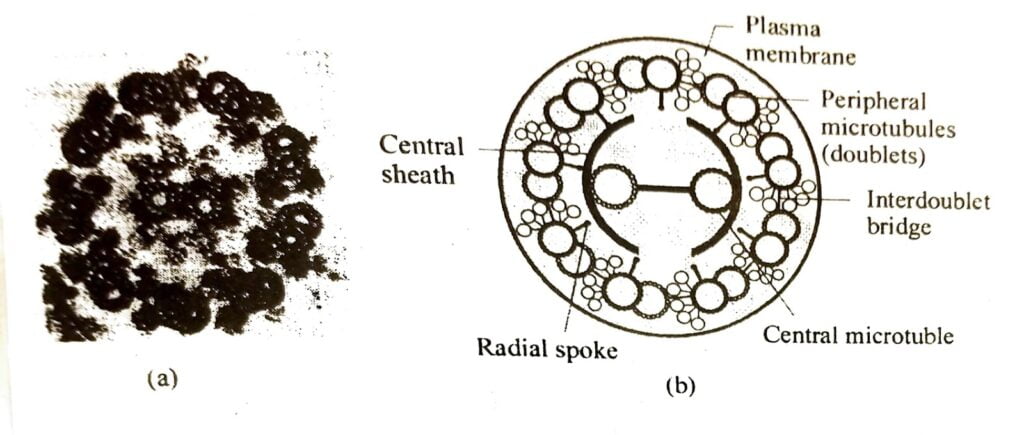
Q.45. How Centro some is related to centrists. White about the structure and function of the centrioles.
Ans :- Centrosome is an organelle containing two cylindrical structures called centrioles. Both centrioles in the a centrosome lie perpendicular to each other.
Each of the centrioles has an organisation like the cart wheel. They are made of evenly peripheral fibrils of tubulin protein. Ealh peripheral fibril is a triplet. The adjacent triplets are also linked. The central part of the proximal region of the centrioles is also proteinous called hub which are connected with the tubules of the peripheral triplets by radial spokes.
The centrioles forms the basal body of the cilia/ flagellum, and also helps in the formation of spindle fibres that help in cell division.
Q.46. Based on the position of Centromere how chromosomes are classified.
Ans :- Based on the position of Centromere chromosomes are classified into 4 types.
(i) Metacentric :- Here the centromere is present in the middle of the chromosome thus forming 2 equal arms of the chromosome.
(ii) Sub metacentric :- Here the centromere is located slightly away from the middle of the chromosome resulting into one shorter arm and one longer arm.
(iii) Areocentric :- Here Centro more is situated close to its end forming on extremely short and one very long arm.
(iv) Telocentric :- Here centromere is located at the terminal end.
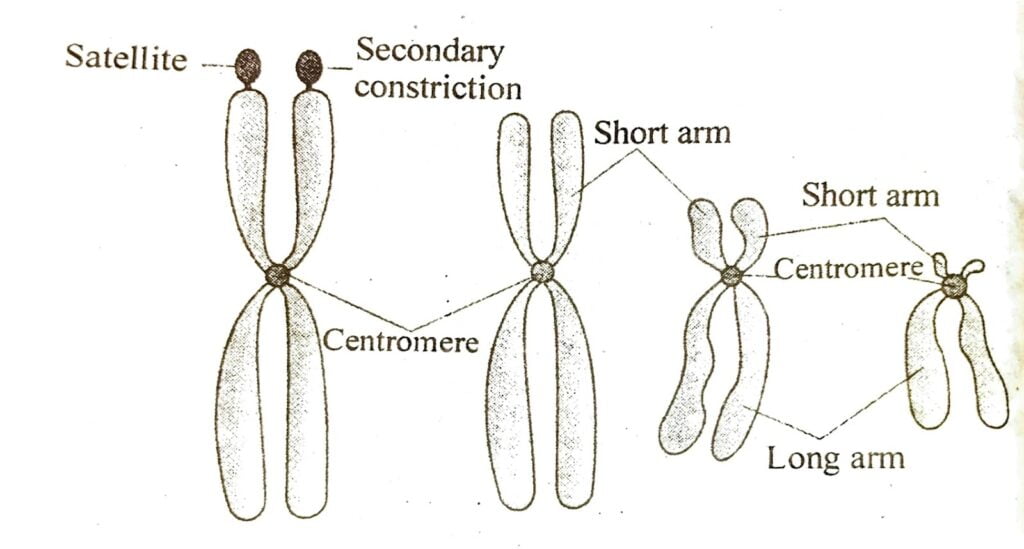
Q.47. Explain the structure of nucleus ?
Ans :- Nucleus is a cell organelle present in all living cell except in some like erythrocytes etc. It is surrounded by nuclear envelope which consist of 2 parallel membranes with a space between it called perinuclear space (form the barrier between the materials present inside the nucleus and that of the cytoplasm) The outer membrane remain continuous with ER. There are numerous nuclear pores in the nuclear envelope. Inside the nucleus it contain nucleoplasm. In the nucleoplasm it contain the nucleolus and chromatin Nucleolus is the site for RNA synthesis.
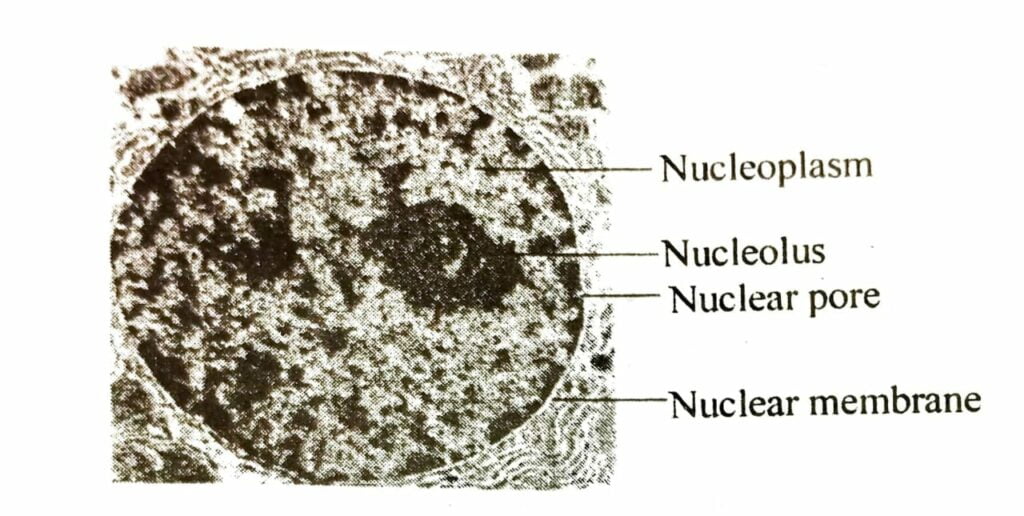
Q.48. What is endomembrane system. Why some of the organelles are not the part of the endomembrane system. How ER, golgi complex, lysosomes coordinates with each other.
Ans :- In a particular eukaryotic cell, many organelles are there and each are distinct in forms of its structures and functions, but still there are some where their functions are coordinates. Such type of organelles together form the endomembrane systems. It includes ER, golgi bodies, lysosomes and vacuoles.
Some organelles like mitochondria, Chloroplast and peroxisomes are not coordinate with ER golgi bodies vacuoles or lysosomes so they are not the part of endomembrane system.
A number of protein synthesised by ribosome on ER are modified in the golgi bodies before they are released.
Lysosome are formed by the process of packaging in the golgi bodies.
In this way ER, golgi bodies and lysosome are related to one another.
Q.49. What are the similarities and dissimilarities between mitochondria and chloroplast.
Ans :- Similarities :-
Both the organelles are not the part of endomembrane system.
Both the organelles are surrounded by double walled membrane.
Both of them have their own DNA molecules and ribosome (70S)
Dissimilarities :-
DNA of mitochondria is single circular but that of chloroplast is double stranded circular DNA.
Although both the organelles possesses double walled membrane, the inner wall of the Mitochondria is folded but that of chloroplast is smooth.
Mitochondria are the site of aerobic respiration whereas chloroplast is present only in green plants and it helps in photosynthesis.

Hi, I’m Dev Kirtonia, Founder & CEO of Dev Library. A website that provides all SCERT, NCERT 3 to 12, and BA, B.com, B.Sc, and Computer Science with Post Graduate Notes & Suggestions, Novel, eBooks, Biography, Quotes, Study Materials, and more.




